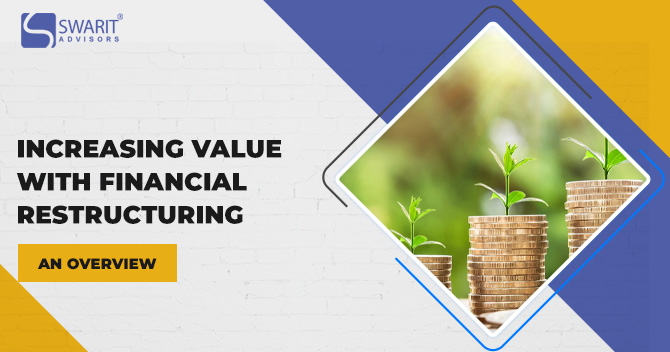Increasing Value with Financial Restructuring – An Overview

Karan Singh | Updated: Aug 14, 2021 | Category: Finance & Accounting
Financial Restructuring is a dedicated proposal undertaken to restructure the financial assets & liabilities of a business to make the most advantageous surrounding for that company. Mainly, it includes rearranging or restructuring share capital & debt. With ineffective Restructuring, entities are often allowed to favourably alter their contractual bonding with lenders, other stakeholders, and shareholders. Financial Restructuring is a corporate action that looks to change the company’s structure and debt operations, with the definitive goal of restricting financial damage besides and authorising it to plug more business opportunities.
Sometimes the restructuring process is linked with corporate Restructuring. In the case of corporate Restructuring, the general composition & function of the company is likely to have an impact, but financial Restructuring is more to do with the financial health of an entity or a company.
Given the ongoing economic emergency due to the Covid-19 pandemic, Restructuring can undoubtedly be a rising area of practice for corporate & finance experts, which can provide them with various opportunities for renewal of unwell business enterprises and their growth.
Table of Contents
What are the Different Types of Financial Restructuring?

- Debt Restructuring: It is an arrangement permitting entities to decrease or negotiate their outstanding debts with the consent of creditors and lenders. By way of this Restructuring, entities can prevent default or take benefit of lower interest rates, extended credit terms etc. It refers to the reallocation of resources by way of altering the debt terms. Following are the types of debt restructuring:
- Stressed Debt Restructuring: It’s a process wherein a company experiencing financial distress and liquidity issues refinance its present debt obligations to increase more flexibility in the short-term and makes their debt more manageable generally. It’s a strategy for keeping the entity afloat & getting the entity back on path financially. Usually, in such conditions, an adjustment is made by the creditor, lender, etc, to smoothen temporary problems towards loan repayment faced by the entity or company.
- Normal Debt Restructuring: In this type of debt restructuring, a relatively healthy company swaps or refinances their high-interest rate debts into low-interest rate debts or amend repayment schedule suiting their business. The entity can also swap its multiple debts having high interest rates and uneven repayment terms into a single debt with good interest rates and repayment terms.
- Conversion of Debt to Equity: It is also known as “Swap[1]”, which is a type of financial restructuring arrangement between the lenders and the company under which the debt sections of the company or entity are converted into equity of the business. In simple terms, the debt providers become owners of the business. A debt-equity swap generally happens in cases where the business is under financial pressure, but the lenders decide to support examining viability in the business model and the promoters’ commitment.
- Equity Restructuring: It is the restructuring process of equity capital. It comprises reshuffling of the shareholders capital and the reserves that are appearing in the balance sheet. Equity restructuring involves a law process and is a highly regulated area wherein the proficiency of corporate professionals is required.
Over capitalisation is a state wherein earnings are not sufficient to validate the fair return on the number of securities issued that have been granted by the company, whereas under capitalisation is a state where the capital which is possessed by the business is less than the borrowed capital. Restructuring can be done in two conditions: Under Capitalisation and Over Capitalisation & suitable strategies can be applied.
- Under Capitalisation: In this case, generally, own capital is much lower than the borrowed capital. Such a situation increases typically when owned capital of the company is dipropionate to the scale of its operations, and its business depends upon more borrowed capital.
Restructuring by way of:
- Restrain to extra borrowings;
- Converting outstanding liabilities to equity;
- Rearranging business by converting firm to company etc.;
- Issuing convertible securities;
- Accepting deposits for shareholders;
- Injecting more capital that is FPO, IPO VC or PE funding, etc.;
- Over Capitalisation: The Company’s earning is not enough to justify a fair return on the amount of share capital & debenture issued. It can be a case also where borrowed funds or total ownership are more than current & fixed assets which represent accumulated loss on the asset side.
Restructuring by way of:
- Reduction of capital;
- Fixed deposit repayment to the public;
- Buyback of shares;
- Debentures or Redeeming bonds;
- Paying extra back shares to shareholders;
- Loan pre-payment to the bank.
Pros and Cons of Debt Restructuring
Pros of Debt Restructuring:
- Protection of business assets;
- Getting company back on path financially;
- Lowering the interest cost;
- Improving financial management.
Cons of Debt Restructuring:
- It affects critical business goals badly;
- Sufficient funds are available to servicing present debt;
- Accessing inexpensive sources of funds is possible;
- Action is started without a proper repayment plan.
What are the Steps Involved in Financial Restructuring?
- Elaborated assessment of short and long-term cash necessities for a company and ensure that business will reach their significant competencies;
- All appropriate stakeholders need to be immediately recognised and mapped into different categories so that they agree to their consent to move to the next step for financial Restructuring. It will safeguard the value and prevent the risk of potential insolvency for the company;
- Stakeholders of the company may plan to confront underlying assumptions which comprise understanding the reasons for underperformance, which may involve interaction with the management team of the company to plan appropriate strategies, initiatives & the business plan of the company;
- The company or entity should improve more than one plan to address possible eventualities. The first stage of appraisal, negotiation & assessment should lay a foundation for the improvement of the financial Restructuring;
- The proposal of financial Restructuring should be prepared considering effective processes, maintain value & tax efficiency;
- Alteration in economic surroundings, new developments and demands from stakeholders may require a planned reworking.
Conclusion
When the suitable action course is agreed upon, it should be executed smoothly and quickly to come out of the existing financial issues without troubling the business. Planning for possible targets for the turnaround of a business, setting aside time to estimate the impact, and being open to creative concepts are also vital for measuring success. But, financial Restructuring is a dynamic process due to which any alterations in external or internal factors comprising economic surroundings can later projections in a big way.
Regularly observing is required across all phases: planning, execution and post-execution stage and after that taking vital corrective steps while considering the condition will find out the success quantum. Financial Restructuring can severely impact the business, and it can yield superior returns by maximising value for all stakeholders. There may be significant costs linked with restructuring exercise; however, still corporate would like to undertake such exercise to get various advantages and create value for their stakeholders.
Read our article:A Comprehensive Analysis of Financial Services Sector












